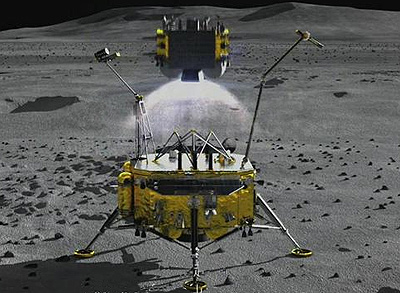Thank you very much for visiting Gunter's Space Page. I hope that this site is useful and informative for you.
If you appreciate the information provided on this site, please consider supporting my work by making a simple and secure donation via PayPal. Please help to run the website and keep everything free of charge. Thank you very much.
Chang'e 5, 6 (CE 5, 6)

Chang'e 5 cruise configuration [Junior Miranda]

Chang'e 5 lander and ascent stage [NAOC]

Chang'e 5 orbiter and return capsule [NAOC]
Chang'e 5 is China's first lunar sample return mission.
The Chang'e 5 mission consists of four parts:
- The orbiter stage, which provides lunar orbit insertion. It houses the return capsule and returns it to earth at the end of the mission.
- The reentry module is a capsule designed for high-speed atmospheric reentry. A prototype has been tested on the Chang'e 5-T1 mission.
- The lander stage, derived from the Chang'e 3 lander, lands on the lunar surface and will dig and collect a lunar sample from up to 2 meters below the surface. The sample is then transfered to the ascent stage on top of the lander. The lander will carry landing cameras, optical cameras, a mineral spectrometer, a soil gas analytical instrument, a soil composition analytical instrument, a sampling sectional thermodetector, and a robotic drilling rig.
- The ascent stage lifts off with the samples and rendezvouses with the orbiter stage in lunar orbit, where the samples will be transfered to the reentry module.
The mission was to be launched in late 2017 on a CZ-5 rocket from Wengchang, but it was delayed to 2019 due to the launch failure of the second CZ-5 rocket and then to November 2020.
Chang'e 5 entered 400 km lunar orbit on 28 November 2020. On the morning of 30 November 2020, the lander with the ascender separated from the lunar orbiter in preparation for landing. The lander and ascender landed on the Moon on 1 December 2020 at 15:11 UTC. The mission's landing zone is near Mons Rümker in Oceanus Procellarum, located in the northwest region of the Moon's near side. This area contains geological units around 1.21 billion years old, compared to the Apollo samples that were between 3.1 and 4.4 billion years old. The location is a large, elevated volcanic mound 70 km in diameter that features a strong spectroscopic signature of basaltic lunar mare material. On 3 December 2020, the ascender lifted off from Oceanus Procellarum at 15:10 UTC and, six minutes later, achieved lunar orbit. The ascender docked with the orbiter-returner combination in lunar orbit on 5 December 2020 at 21:42 UTC, and the samples were transferred to the return capsule at 22:12 UTC. Undocking of the ascender from the orbiter-returner combination took place on 6 December 2020 at 04:35 UTC. After completing its role in the mission, the ascender was commanded to deorbit on 7 December 2020 at 22:59 UTC, and crashed into the Moon's surface at 23:30 UTC, in the area of (~30°S, 0°E). On 13 December 2020 at 01:51 UTC, from a distance of 230 kilometers from the lunar surface, the orbiter and returner successfully fired four engines to enter the moon-Earth Hohmann Transfer orbit. On 15 December 2020, the return capsule landed back on earth.
A second sample return mission, Chang'e 6 is being built as a back-up. If Chang'e 5 is successful, Chang'e 6 will be repurposed for a landing at the lunar south pole around 2023.
| Nation: | China |
|---|---|
| Type / Application: | Lunar lander and rover |
| Operator: | CNSA |
| Contractors: | CAST |
| Equipment: | |
| Configuration: | |
| Propulsion: | ? |
| Power: | 2 deployable solar arrays, batteries (orbiter); 2 deployable solar arrays, batteries (lander); solar cells, batteries (ascent stage); batteries (return capsule) |
| Lifetime: | |
| Mass: | 8200 kg (launch) |
| Orbit: |
| Satellite | COSPAR | Date | LS | Launch Vehicle | Remarks | |
|---|---|---|---|---|---|---|
| Chang'e 5 (CE 5) | 2020-087A | 23.11.2020 | We LC-101 | CZ-5 | ||
| Chang'e 6 (CE 6) | - | 2024 | We LC-101 | CZ-5 |
References:
- CAST Website
